Bees and Wasps
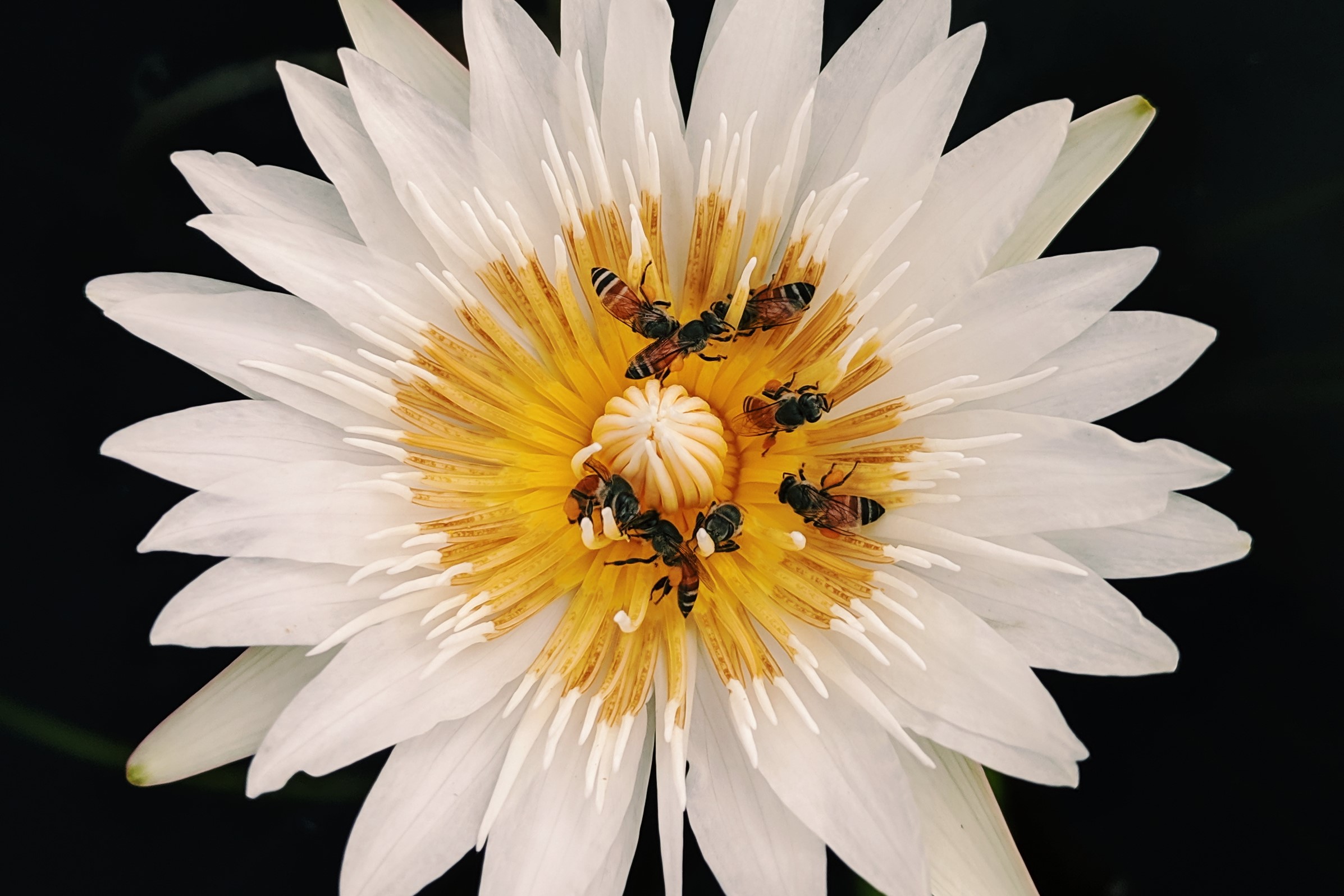
Photo: Giant Honey Bees (Apis dorsata) foraging on a water lily flower. (Credit: Tan Jing Wen)
What are they?
Bees and wasps (together with ants) form the large insect order Hymenoptera. Many species have a constriction between their thorax and abdomen, giving the appearance of a prominent ‘waist’. Females also have a stinger with glands that secrete venom, which is in fact a modified ovipositor (an organ used to lay eggs). This is why only female bees and wasps can sting!
Why are they important?
Bees and wasps play important roles in our forests, parks and gardens. Bees are important pollinators – animals that transport pollen from the male flower to the female flower. Without them, many plants would not be able to develop fruits and seeds. Meanwhile, wasps function as predators of other small insects, keeping their populations in check.
Are they dangerous?
It is safe to view bees and wasps while they’re at flowers, as they will only get aggressive when their nests are threatened. Their presence is a welcome sight as many of the plants in our parks and garden rely on them to reproduce, in turn providing food for other organisms. They also increase the fruit yield of many popular edible plants such as brinjals and gourds.
Here are some of the bees and wasps that you can see in Jurong Lake Gardens.
Honey Bees
Honey bees are highly social bees of the genus Apis. They are native to Eurasia and Africa but certain species have been distributed worldwide (except Antarctica) by people for honey production. They are known for their complex social systems and nests, which are combs made from wax.
Their primary diet is nectar and pollen. They are generalist pollinators that visit a wide range of flowers with easily accessible pollen and nectar. Usually, an individual scout bee searches for flowers using a combination of sight and smell. It then communicates its location to others by doing a dance. By rapidly recruiting its sister worker bees, it can efficiently collect large amounts of pollen.
Caution should be taken when a hive is found as honey bees will readily sting to protect their home when threatened or disturbed. However, they are docile and safe when foraging away from their nest.
Four species of honey bees are found in Singapore:
Asian Honey Bee
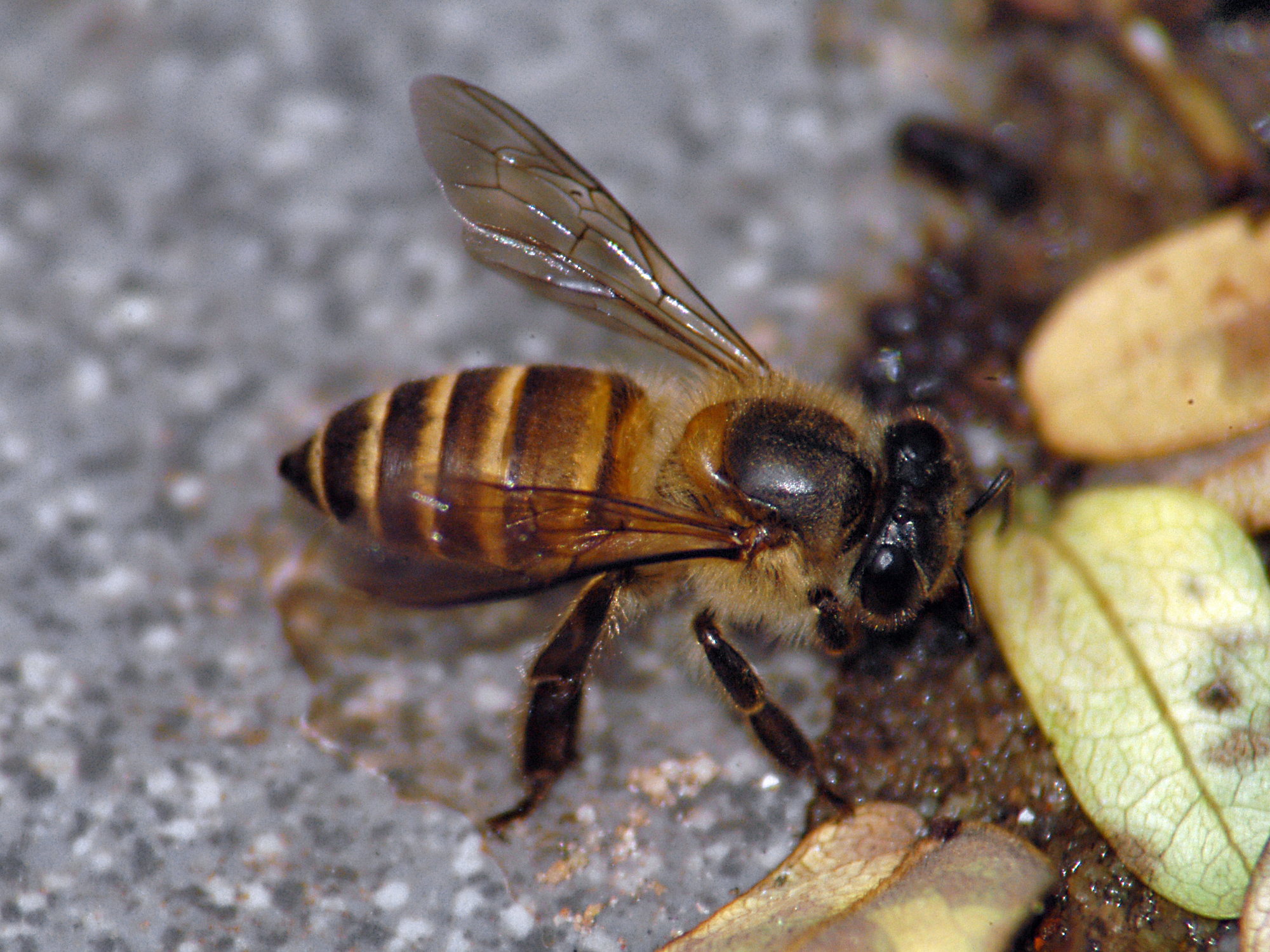
Photo credit: John X. Q. Lee
|
Scientific name: |
Apis cerana |
|
Common name: |
Asian Honey Bee |
|
Family: |
Apidae |
What does it look like?
This species has yellow and brown/black bands. It is smaller than the
Giant Honey Bee and has an additional brown/black band across the abdomen.
It is the most common bee in Singapore.
Behaviour and Ecology
They usually build their nests in enclosed areas, such as tree holes.
In urban environments, they might also use upturned pots and roofs. Their
hives consist of multiple wax combs lined parallel to one another.
Giant Honey Bee
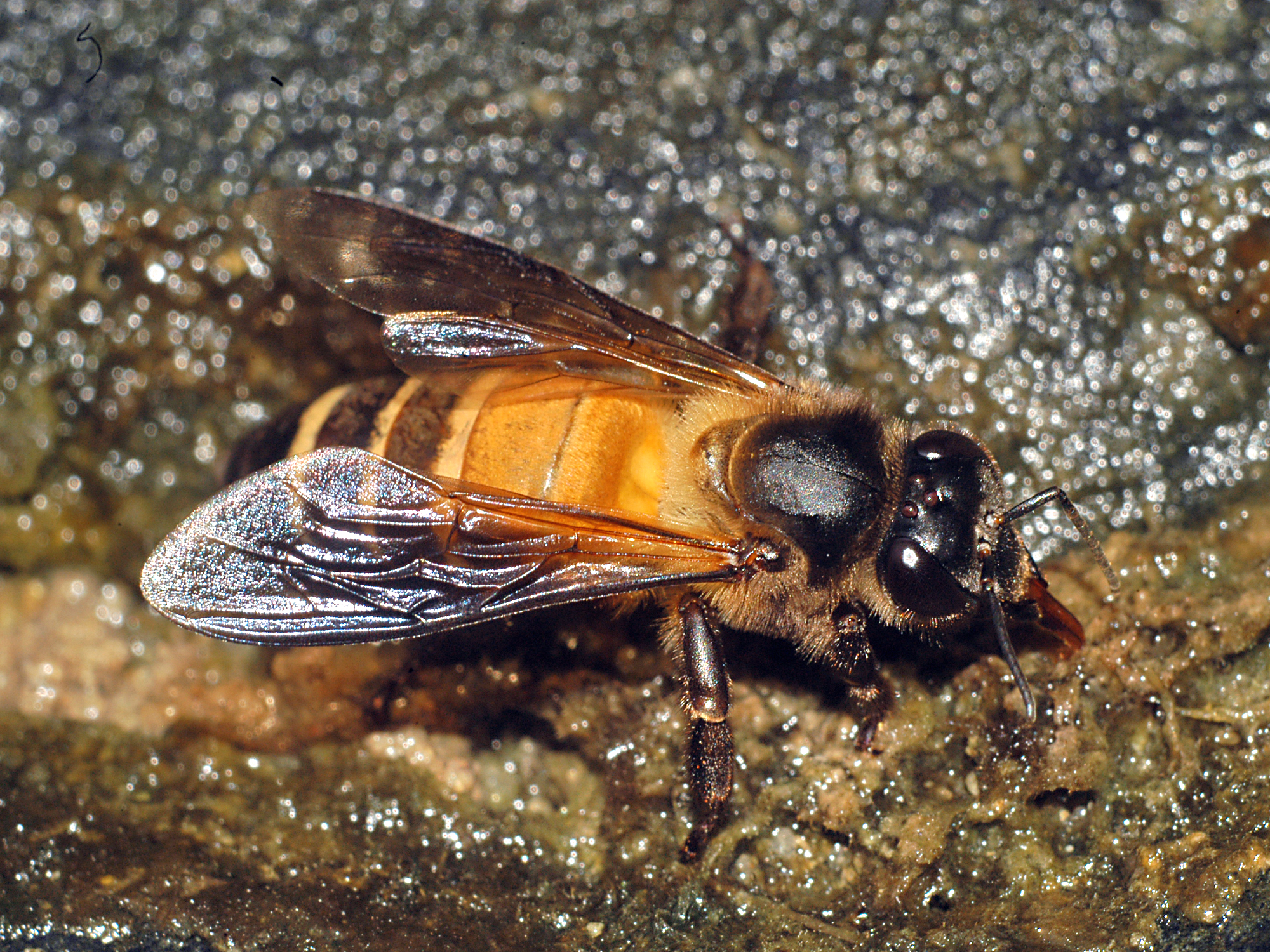
Photo credit: John X. Q. Lee
|
Scientific name: |
Apis dorsata |
|
Common name: |
Giant Honey Bee |
|
Family: |
Apidae |
What does it look like?
The largest of the honey bee species found in Singapore, it has one less brown/black band at the top of the abdomen as compared to the Asian Honey Bee.
Behaviour and Ecology
It is more commonly found in forested areas where it builds its nest hanging from tree branches. The nests usually consist of a large, open single comb that may support up to 100,000 workers. It is aggressive when its nest is provoked, but this has not stopped the indigenous people of Southeast Asia from collecting the beeswax and honey produced by this species.
Unlike other honey bee species, it can actively forage after dusk and
is often attracted to artificial light sources.
Dwarf Honey Bees
Black Dwarf Honey Bee
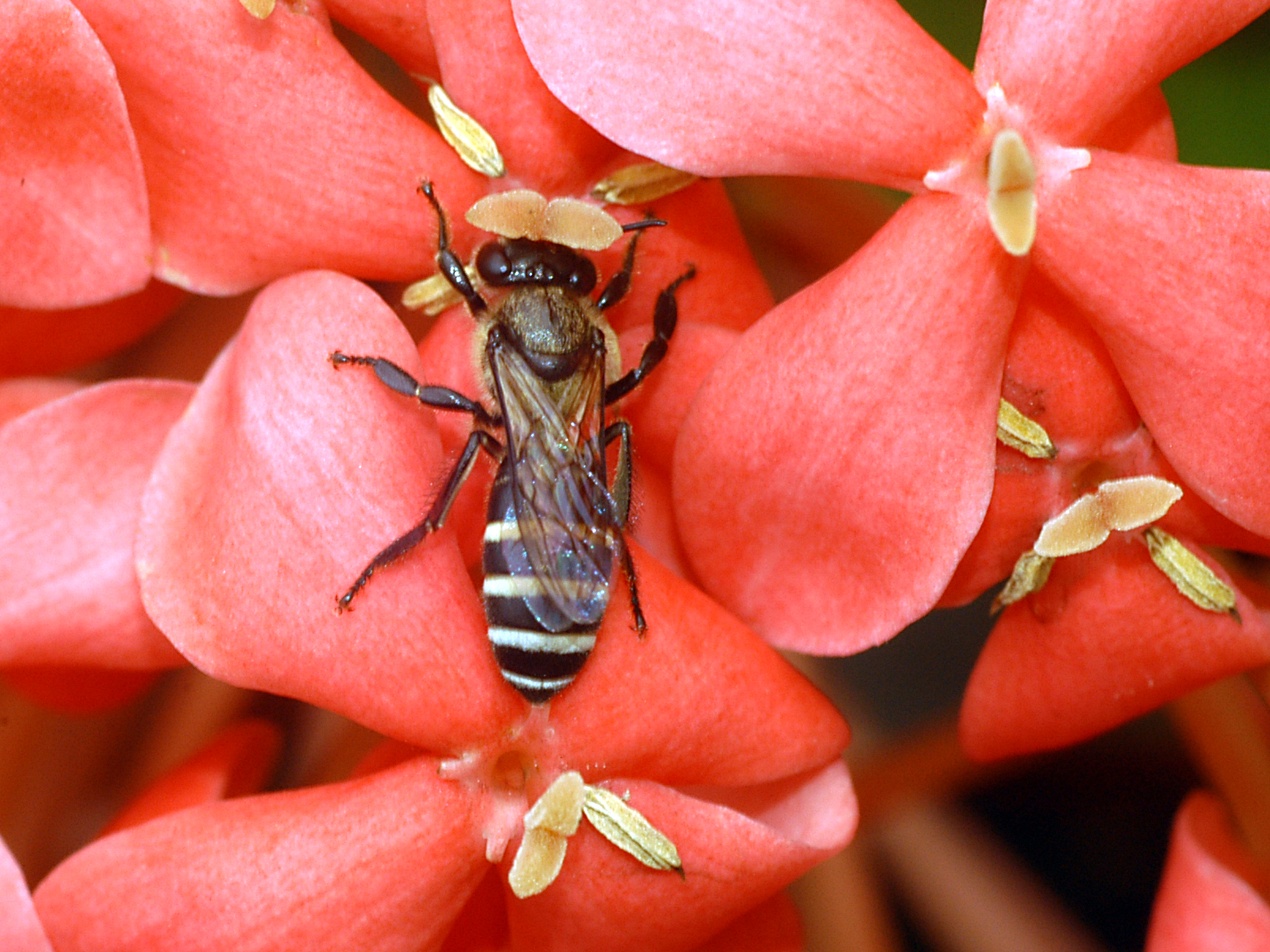
Photo credit: John X. Q. Lee
|
Scientific name: |
Apis andreniformis |
|
Common name: |
Black Dwarf Honey Bee |
|
Family: |
Apidae |
Red Dwarf Honey Bee
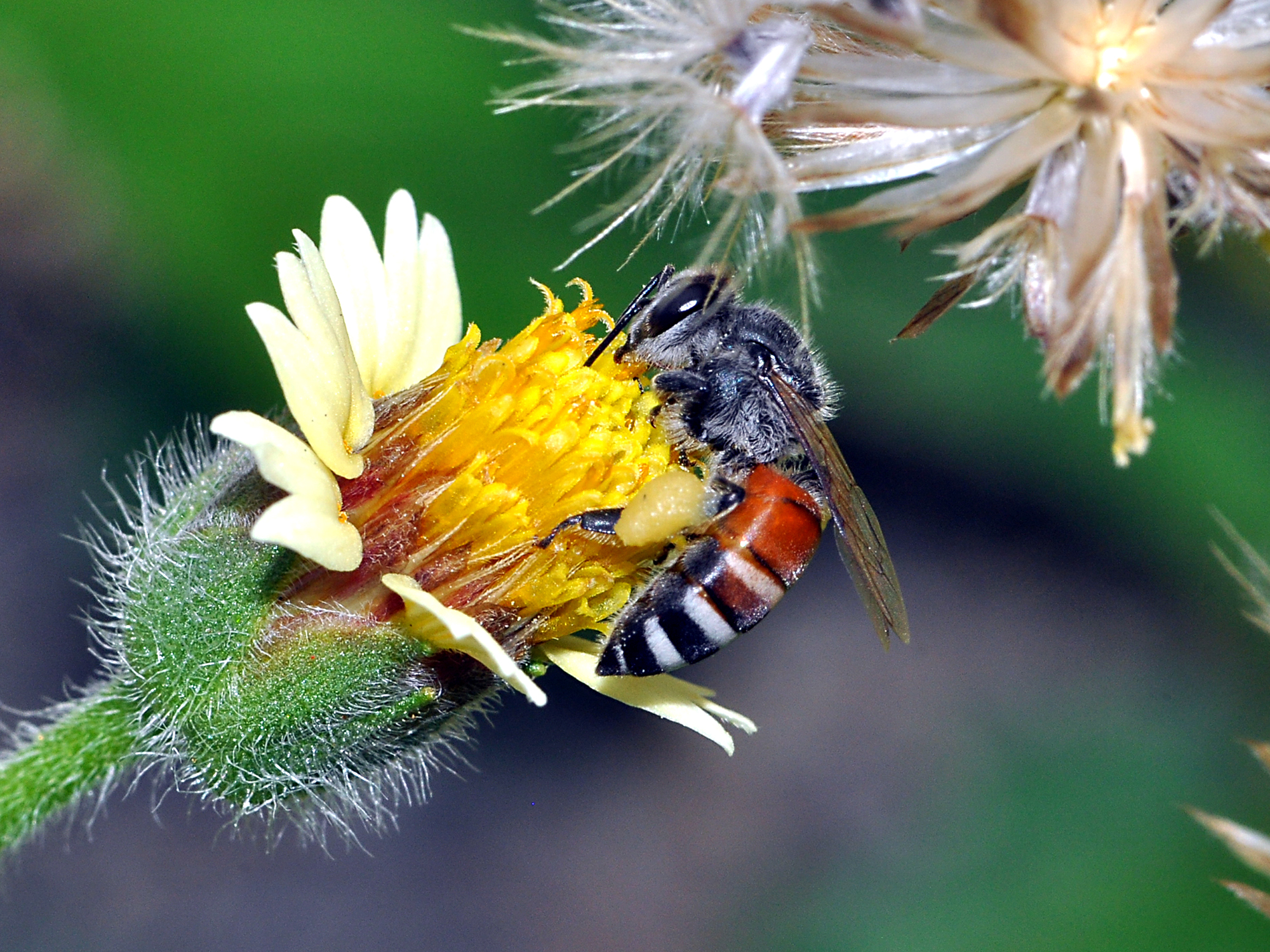
Photo credit: John X. Q. Lee
|
Scientific name: |
Apis florea |
|
Common name: |
Red Dwarf Honey Bee |
|
Family: |
Apidae |
What do they look like?
The smallest of the honey bee species, the Red Dwarf Honey Bee can be told apart by its reddish orange colouration on the first few segments of its abdomen as compared to the black colouration of the Black Dwarf Honey Bee. In addition, the Red Dwarf Honey Bee has a grey thorax while the Black Dwarf Honey Bee has a brown one.
Behaviour and Ecology
These bees are fairly common in our parks and gardens. In contrast to the Giant Honey Bee, they build their nests lower in vegetation. They apply a band of sticky plant resin to the twigs supporting their small, single-comb nest to keep out ants that may try to attack them. They are naturally nomadic, and will abandon their hive to find a new nesting site within three to six months.
Dwarf Honey Bees are not regarded as dangerous and aggressive, only attacking
in cases of severe disturbance to their nest. Furthermore, their stings
are inefficient and do not pierce the skin of adults easily.
Blue-banded Bees
Sunda Blue-banded Digger Bee

Photo credit: Zestin Soh (NParks)
|
Scientific name: |
Amegilla andrewsi |
|
Common name: |
Sunda Blue-banded Digger Bee |
|
Family: |
Apidae |
What does it look like?
Its abdomen is striped with alternating brilliant blue and black bands and has orange brown hair covering its thorax. Despite its speedy flight, its vibrant blue bands are easily recognisable.
Behaviour and Ecology
Blue-banded Digger Bees are solitary bees that have the ability to buzz pollinate flowers. Clinging onto the flower’s anthers, the bee vibrates its body at a particular frequency that causes pollen from the flower to be released. They nest in the ground, particularly in clayey soil. In urban environments, they are known to use man-made surfaces such as mortar between bricks and concrete as nests instead.
You will rarely ever get stung from this species as they are shy and docile creatures. Their presence is a welcome sight in our parks and gardens.
Carpenter Bees
Carpenter bees from the genus Xylocopa are large and often hairy bees that are usually dark coloured and about 20-30 mm in length.
True to their name, they create burrows in solid wood, usually dead tree trunks and branches or timber used for construction. These burrows branch out into many parallel passageways. Brood cells in their nest are filled with pollen and deposited with a single egg each. Unlike honey bees, which live in colonies with a single egg-laying female (the queen), Carpenter Bees are considered solitary bees which live singly or in small groups. All females are able to reproduce.
In addition to being large, they also buzz loudly while foraging for nectar and pollen from many trees and shrubs. Despite this, they are peaceful giants that are relatively docile and harmless. They carry out buzz pollination, where they grab onto flowers and buzz at a specific frequency, releasing pollen in the process. They function as pollinators of many local plants such as Sendudok (Melastoma malabathricum) and Simpoh Air (Dillenia suffruticosa).
About 13 species of carpenter bees have been recorded in Singapore. Here
are some common species found in Jurong Lake Gardens.
Broad-footed Carpenter Bee
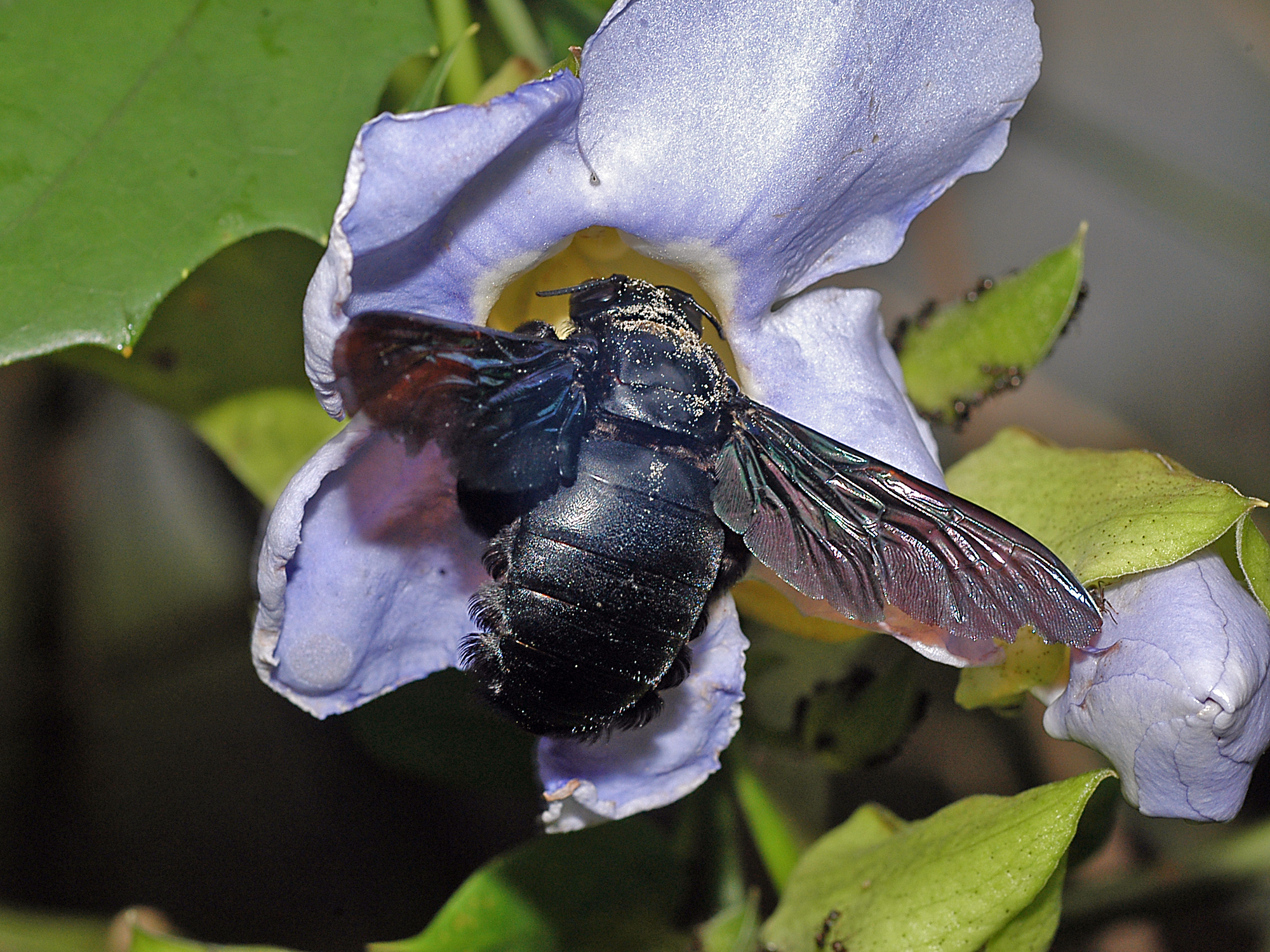
Photo credit: John X. Q. Lee
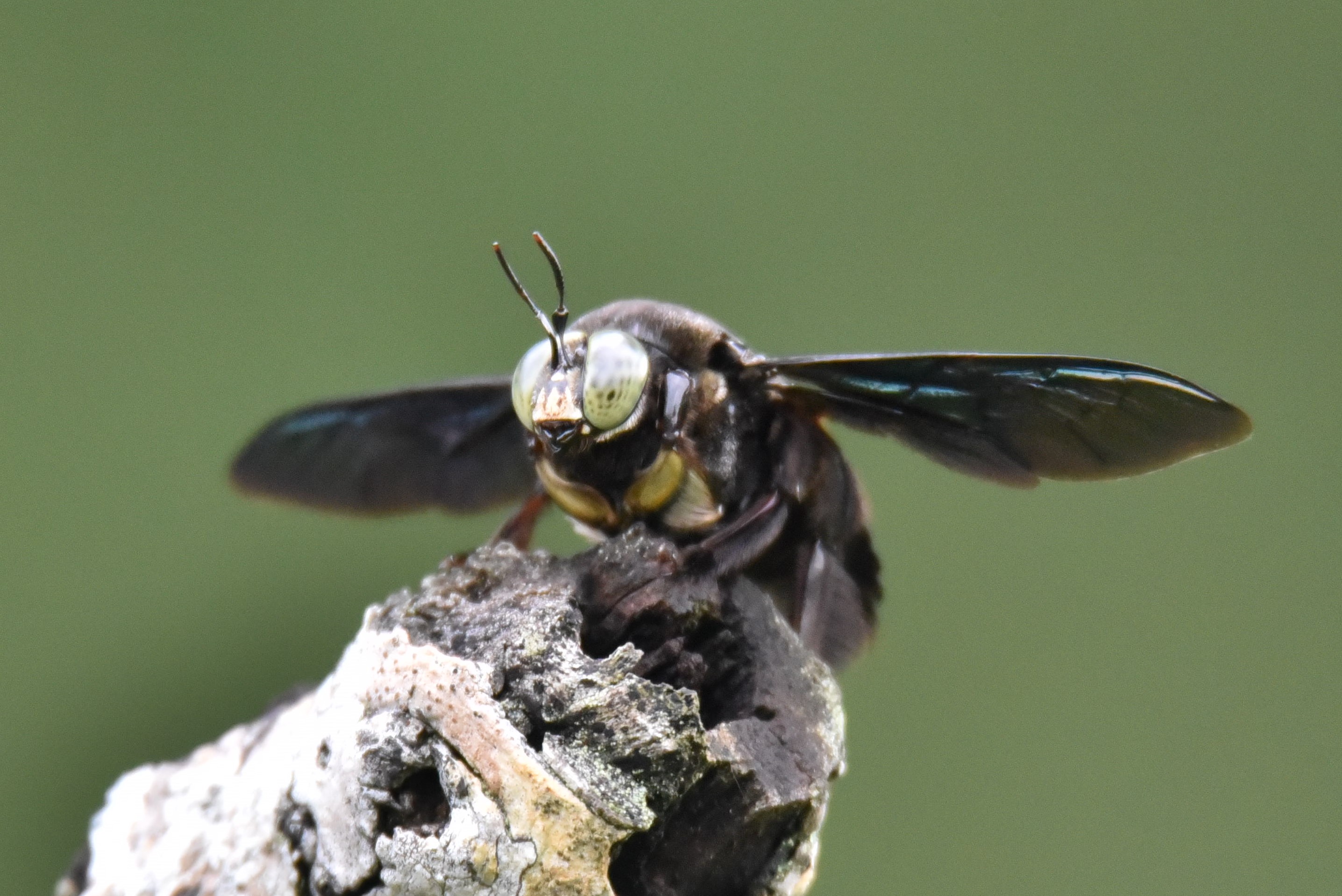
Photo credit: Nicholas Kee (NParks)
|
Scientific name: |
Xylocopa latipes |
|
Common name: |
Broad-footed Carpenter Bee |
|
Family: |
Apidae |
What does it look like?
The all-black Broad-footed Carpenter Bee is the largest bee in Singapore, and also one of the largest in the world. It is shiny and fully black with metallic blue green or purple wings in sunlight. It has a distinctive, low-pitched buzzing that can be heard while foraging. Males have unusual front legs that are lighter in colour and covered in smooth, brush-like hairs.
White-cheeked Carpenter Bee
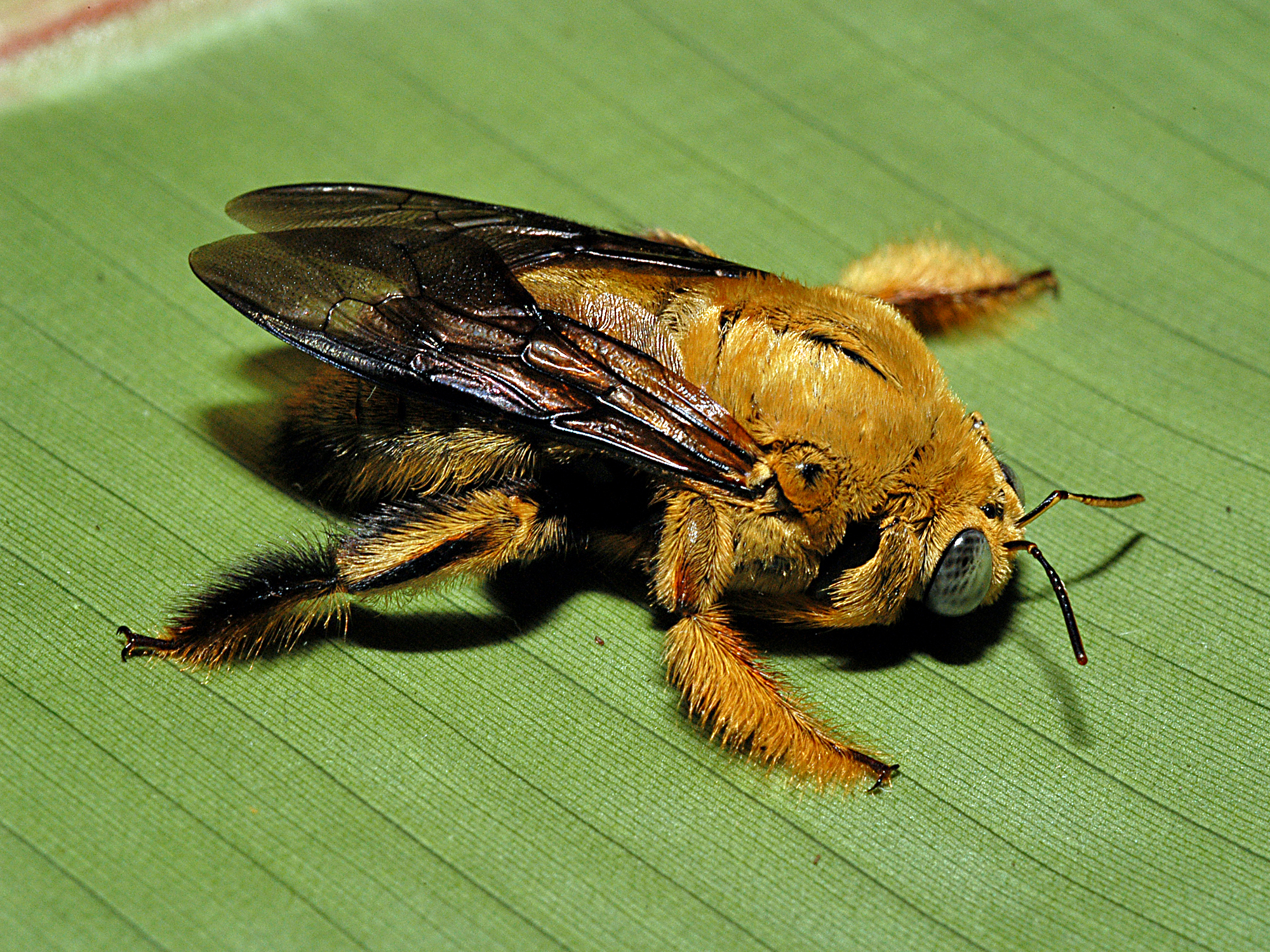
Male. Photo credit: John X. Q. Lee
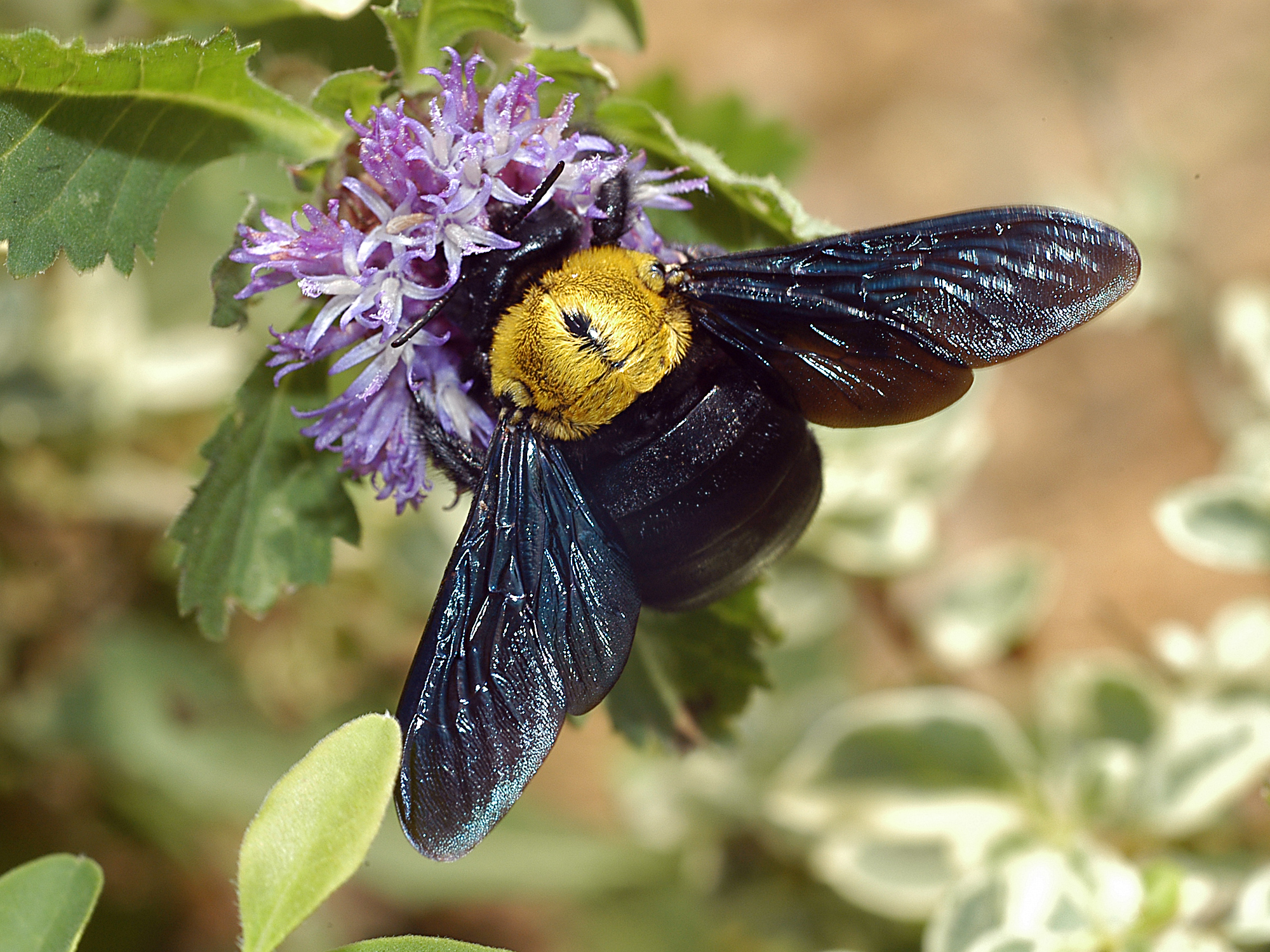
Female. Photo credit: John X. Q. Lee
|
Scientific name: |
Xylocopa aestuans |
|
Common name: |
White-cheeked Carpenter Bee |
|
Family: |
Apidae |
What does it look like?
The female is mainly black with a thorax covered with deep yellow hairs except for a small black patch in the centre. The male, in contrast, is covered with fine yellow hairs, making it look fully dark yellow. They are named after a small patch of fine white hairs found behind their eyes in both sexes.
Females are often mistaken for the Yellow-and-black Carpenter Bee (X. flavonigrescens), though one way to tell them apart is to look at the luminous colours, known as iridescence, of their wings. Female White-cheeked Carpenter Bees have a purplish brown iridescence on their wings as compared to the bluish-green iridescence of the Yellow-and-black Carpenter Bee.
Yellow-and-black Carpenter Bee
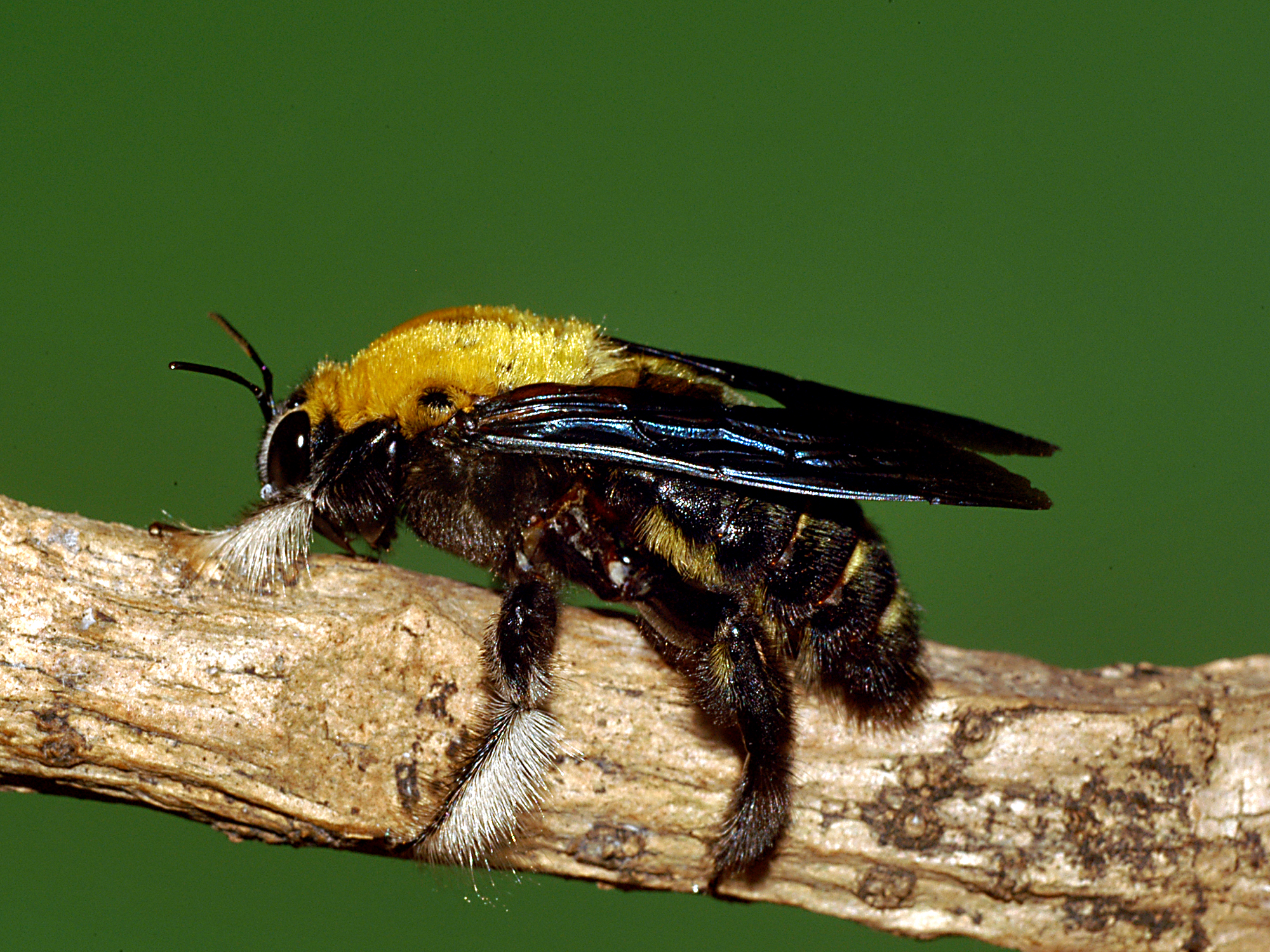
Male. Photo credit: John X. Q. Lee
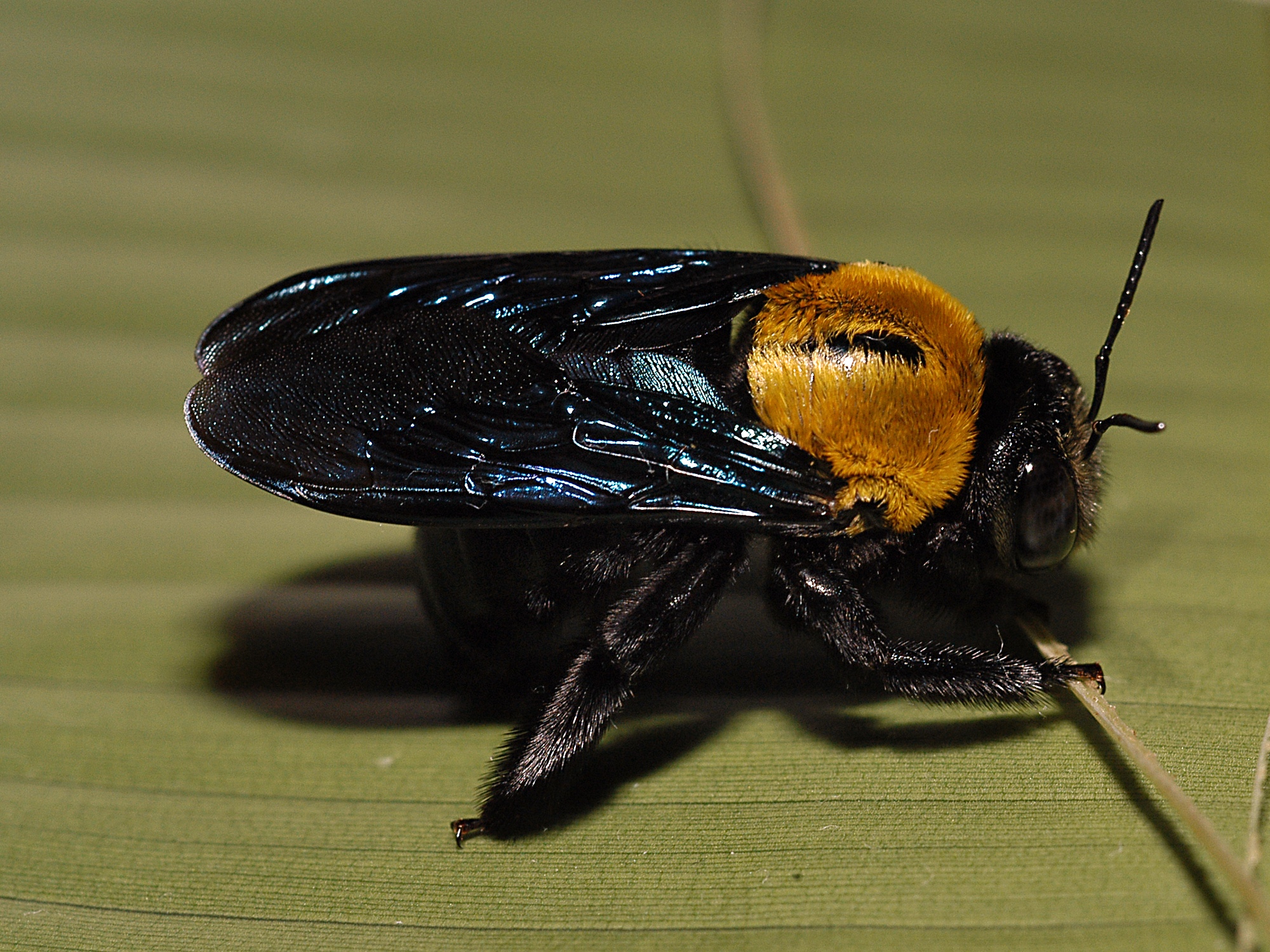
Female. Photo credit: John X. Q. Lee
|
Scientific name: |
Xylocopa flavonigrescens |
|
Common name: |
Yellow-and-black Carpenter Bee |
|
Family: |
Apidae |
What does it look like?
Females are often mistaken for the White-cheeked Carpenter Bee as they
look exceedingly alike, though one way to tell them apart is to look at
the iridescence of their wings. Males are easier to differentiate as their
thorax is a more vibrant yellow that gets progressively darker towards
the end of the abdomen.
Megachilid Bees
These bees are from the family Megachilidae and are solitary or brood parasites of the nests of other bees, in contrast to the social groups of honey bees. Their nests come in all forms, ranging from soil and stem burrows, wood burrows made by beetles, on rocks, to stems and leaves. They supplement their nests with other materials, which explains their common names of Leaf-cutter Bees and Resin Bees.
Disjunct Resin Bee
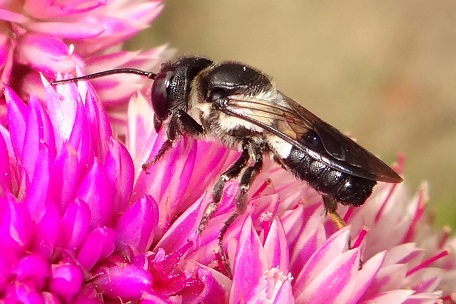
Photo credit: Ong Kwan Han
|
Scientific name: |
Megachile disjuncta |
|
Common name: |
Disjunct Resin Bee |
|
Family: |
Megachilidae |
What does it look like?
Megachilid bees like the Resin Bee have a more rectangular or oblong shape than other bees. The Disjunct Resin Bee is black with purplish metallic wings and has a patch of white hairs on the top of its abdomen near the thorax. It stores its collected pollen on the underside of its abdomen while foraging, rather than on its hind legs like other bees.
Wasps and Hornets
The term wasps usually refer to social wasps from the family Vespidae, but may also refer to other families that share a similar appearance. Wasps have a slender body form and a distinctive petiole (stalk) in the middle of their body. Unlike bees, they are unable to produce wax and instead use mud or chewed up wood pulp to strengthen their nests. They can also sting multiple times, unlike honey bees.
While they are carnivorous, they supplement their diet with sugar from ripe fruits, insect honeydew and tree sap. They have stings used to kill prey such as caterpillars and other smaller insects. When defending their nests, they can be particularly aggressive.
Hornets are from the genus Vespa and are the largest of the eusocial wasps. They mainly prey on insects like houseflies, caterpillars, grasshoppers and other smaller bees and wasps. Sometimes, a large group of hornets may raid a honey bee hive not just for its honey, but also for the bee larvae and pupae found inside.
Pear-tailed Potter Wasp
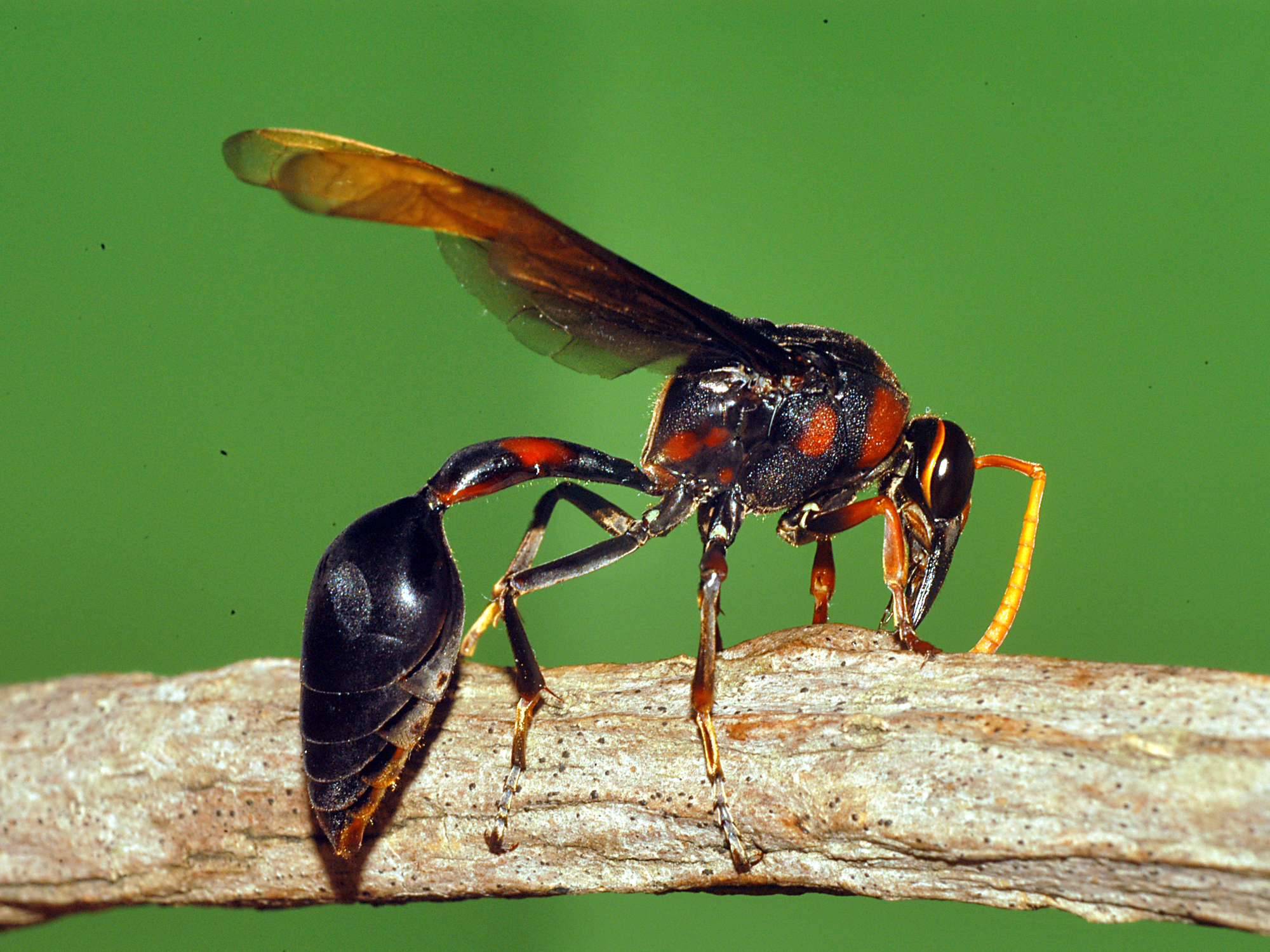
Photo credit: John X. Q. Lee
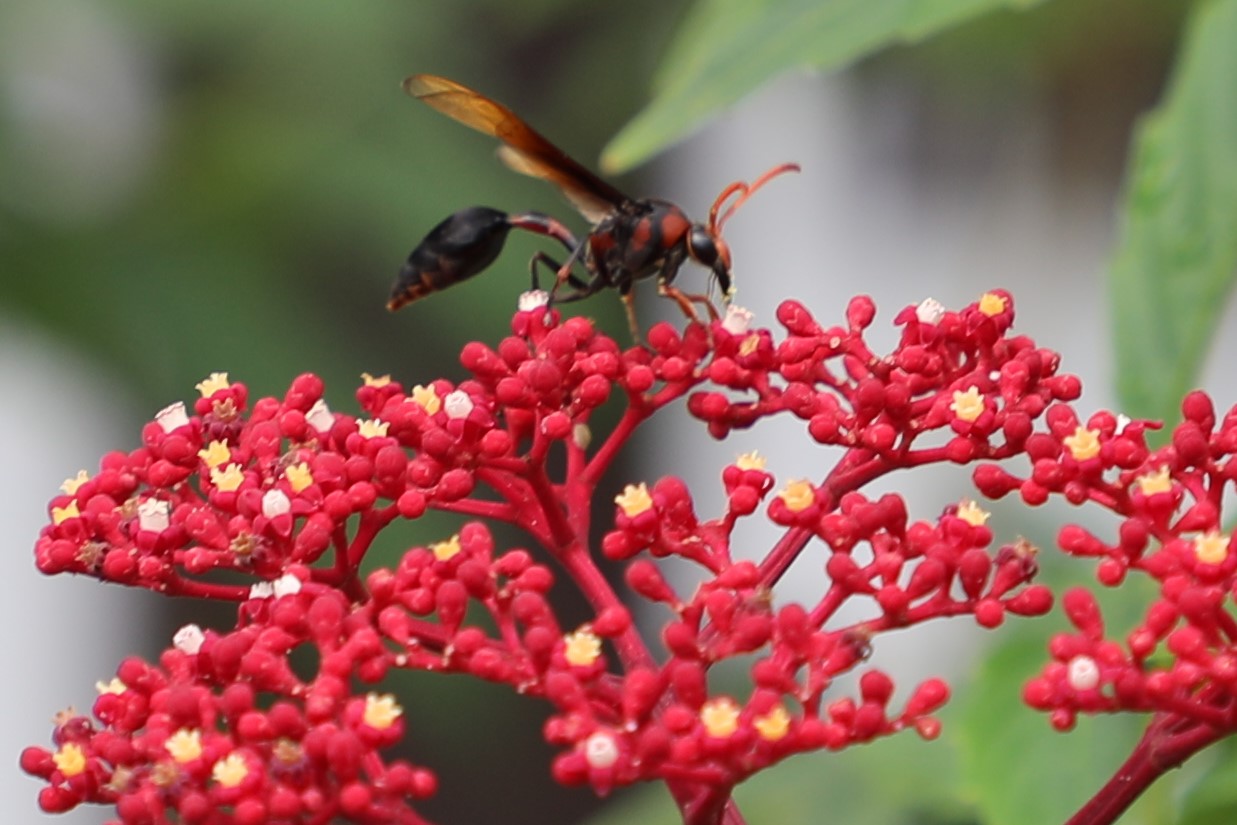
Photo credit: Nicholas Kee (NParks)
|
Scientific name: |
Delta pyriforme |
|
Common name: |
Pear-tailed Potter Wasp |
|
Family: |
Vespidae |
What does it look like?
In Singapore, Potter Wasps in general can be identified by their particularly long petioles (waists) and their black and reddish brown colouration in adults. Both males and females are fully winged.
Behaviour and Ecology
The Pear-tailed Potter Wasp is a commonly seen wasp species in Singapore that is well-adapted to both urban and natural habitats.
Nests: Its nest consists of pot-shaped cells that are covered with a layer of mud, hence its name. It builds its nest on tree trunks, branches and on man-made structures. The female lays an egg in each cell and stores it with a paralysed prey before sealing it with mud. Once hatched, the wasp larva eats the stored prey.
Behaviour: Despite its large size, it is relatively harmless if left alone and is more likely to flee than attack.
Banded Paper Wasp

Photo credit: John X. Q. Lee
|
Scientific name: |
Polistes sagittarius |
|
Common name: |
Banded Paper Wasp |
|
Family: |
Vespidae |
What does it look like?
It is a medium-sized wasp that is mostly black with reddish brown on parts of its thorax and the front of its head. Its most striking feature is its abdomen that starts with a small dark brown band, followed by a larger deep yellow band. Its wings are tinged brown at the base. It may be confused with the Lesser Banded Hornet (Vespa affinis), but is noticeably more slender.
Behaviour and Ecology
Nests: Paper wasps build their nests by gathering fibres from dead wood and plant stems. After mixing them with their saliva, the paper-like material is applied in layers onto surfaces to create a tough, water-resistant paper when dried. The nests are attached to surfaces with a distinct stalk. The combs of the nest are open and are protected by a chemical secreted by the wasp that repels predators such as ants.
Behaviour: Paper wasps are generally non-aggressive and will only attack if threatened. Paper wasps like P. sagittarius prey almost exclusively on caterpillars, including many pest species. This makes their presence very beneficial to plant nurseries!
Lesser Banded Hornet
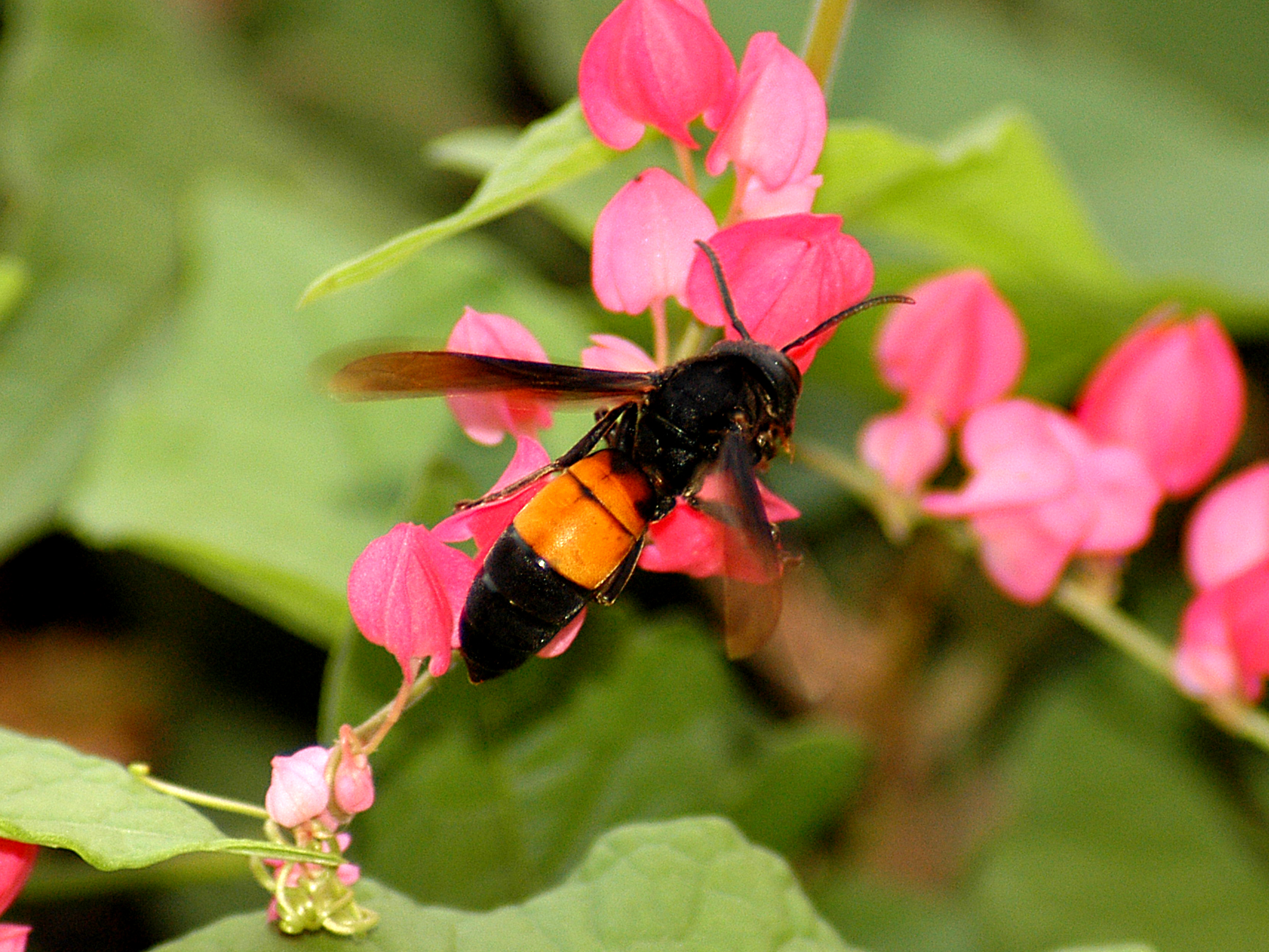
Photo credit: John X. Q. Lee
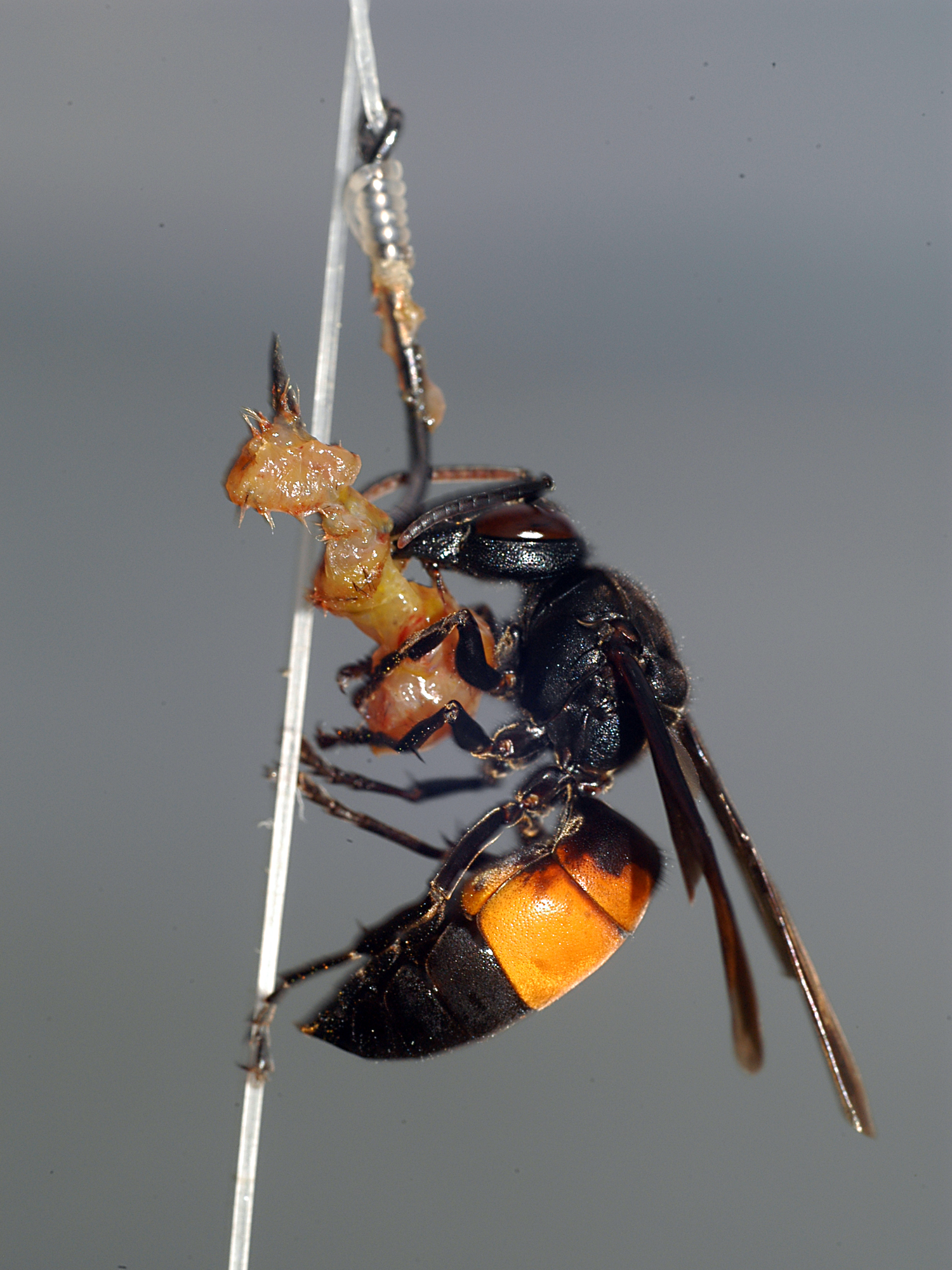
Photo credit: John X. Q. Lee
|
Scientific name: |
Vespa affinis |
|
Common name: |
Lesser Banded Hornet |
|
Family: |
Vespidae |
What does it look like?
It is a small to medium-sized hornet that is fully black with the first two abdominal segments forming a brilliant orange band. It can be told apart from the Banded Paper Wasp by its stouter body.
Behaviour and Ecology
Nests: Hornets generally have larger colonies than other wasps and make larger nests made of chewed rotten wood mixed with saliva. They are built on small trees, bushes and even uncovered sites on buildings.
Behaviour: The Lesser Banded Hornet colonies are founded by multiple queens. While they respond aggressively to disturbances of their nest, they will otherwise not attack unprovoked.
Greater Banded Hornet

Photo credit: John X. Q. Lee
|
Scientific name: |
Vespa tropica |
|
Common name: |
Greater Banded Hornet |
|
Family: |
Vespidae |
What does it look like?
It is a medium to large-sized hornet. The colour of this species varies based on locality, but in Singapore it is usually black with a distinct bright orange band on its abdomen. It can be told apart from the Lesser Banded Hornet (Vespa affinis) by its generally larger size. Its orange band lies only on the second segment of the abdomen while the band on the Lesser Banded Hornet also partially covers the first segment.
Behaviour and Ecology
Nests: Their globular nests may be constructed in various locations, including underground, in enclosed spaces such as tree hollows, or high on trees. The surface of the nest is often covered with intricate, ripple-like patterns.
Behaviour: Greater Banded Hornets tend to fly high in trees under the cover of dense foliage. They are known for their raids on Paper Wasp (Ropalidia spp.) nests, where they will kill the adults and take the larvae back to feed their own larvae. They may defend their nest aggressively when provoked so it is important not to disturb their nests.
Yellow-vented Hornet
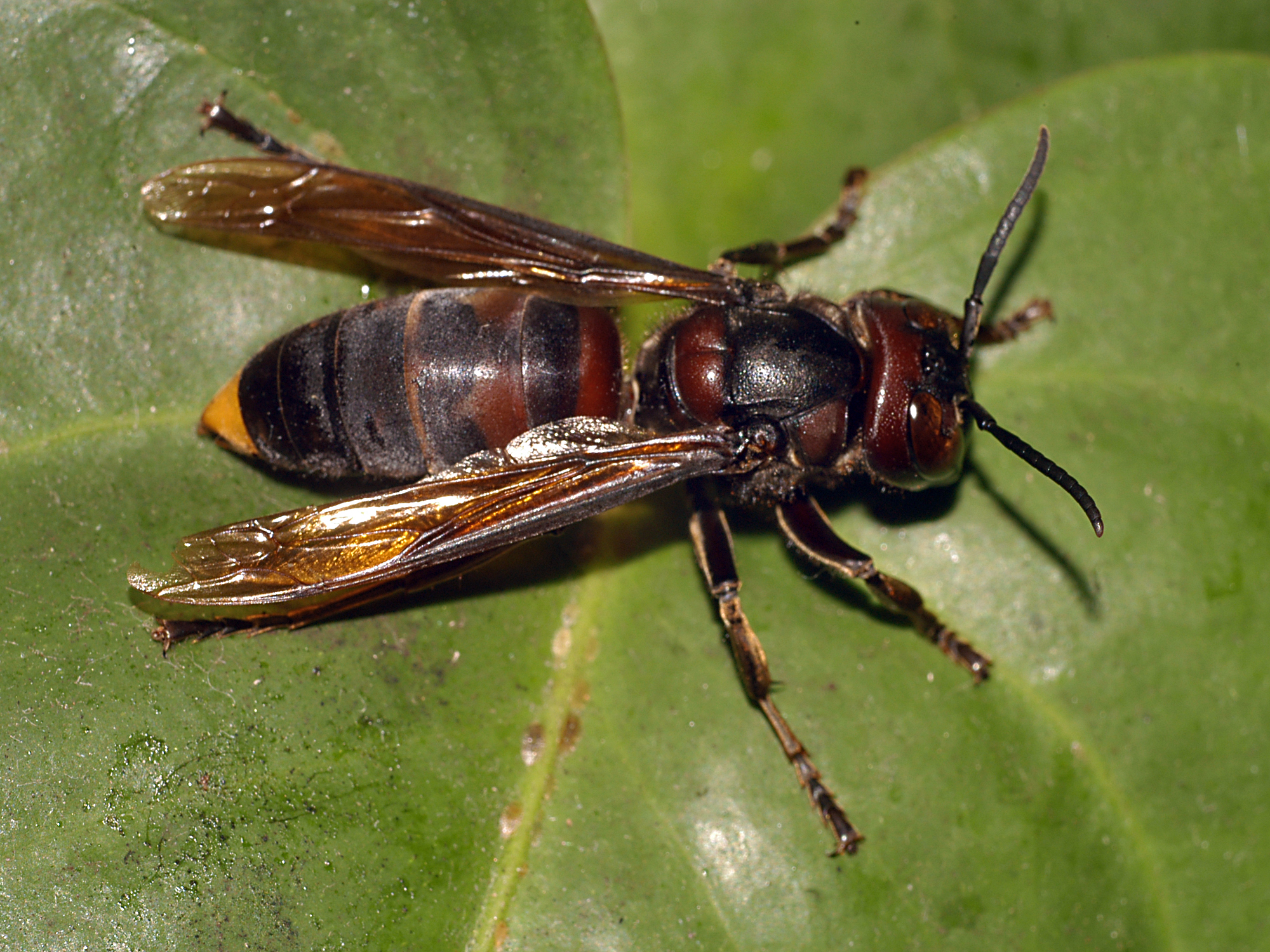
Photo credit: John X. Q. Lee
|
Scientific name: |
Vespa analis |
|
Common name: |
Yellow-vented Hornet |
|
Family: |
Vespidae |
What does it look like?
It is a medium to large-sized hornet. The populations in Singapore and in the Southeast Asian region are mainly black with yellow only on the tip of its abdomen.
Behaviour and Ecology
Nests: It normally builds its nests on trees and thick foliage.
Behaviour: It is one of the less aggressive hornet species found in Singapore and will only attack humans when greatly provoked.

